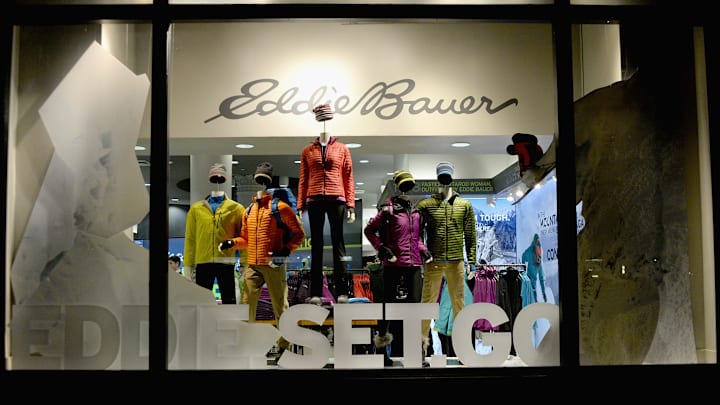If David Abercrombie had known what his store was going to become when he founded it in 1892, he probably he would have been stunned. It’s amazing what years of evolution and buyouts can do to a company’s original vision—here’s what Abercrombie and Fitch and nine other clothing retailers sold when their doors first opened.
1. Abercrombie & Fitch

When Abercrombie Co. opened in Manhattan in 1892, it sold excursion goods. In fact, it sold adventurer-type items to no less than Theodore Roosevelt, Amelia Earhart, and Charles Lindbergh. As it became more popular (and after Ezra Fitch came on board in the 1900s), the flagship store on Madison Avenue—which opened in 1917—housed a shooting range, a golf school with a resident pro, a kennel for cats and dogs, and a small pool for fly-fishing lessons.
2. Banana Republic

Banana Republic was created in 1978 by Mel and Patricia Ziegler and opened its first store in Mill Valley, California. The original Banana Republic got most of its sales through a hand-illustrated catalog that included product reviews from writers like Hunter S. Thompson and Nora Ephron. In 1983, Gap, Inc. purchased Banana Republic, which at that point had just two stores. After that, when stores were added, they carried out the safari theme wholeheartedly with real Jeeps, exotic plants, and fog.
3. Gap

The Gap opened its first store on San Francisco’s Ocean Avenue in 1969. Perhaps a sign of the times, it sold nothing but men’s Levi’s and records. By the next year, they had expanded to a store in San Jose and added Levi’s for women to its inventory. The brand debuted its first jeans in 1974.
4. Eddie Bauer

In 1920, when he was 21, Eddie Bauer opened “Bauer’s Tennis Shop”—really just a space inside another store where he sold tennis rackets—in Seattle. It was only open during the tennis season, but was successful enough to allow him to expand the store to handmade golf clubs and fishing tackle. That’s when he changed the store name to “Eddie Bauer’s Sport Shop.” Later, Bauer had a near death experience that inspired the first patented down jacket—and the success of that product changed his business forever.
5. Kohl’s

Prior to Kohl’s Department Store, Max Kohl opened Kohl’s supermarket, which eventually became Kohl’s Food Stores—and instead of abandoning his original concept entirely, Kohl expanded into department stores and kept both. Kohl’s Food Stores were sold to A&P in 1983 and were known as Kohl’s II, but those are now defunct.
6. Bloomingdale’s

Talk about a specific market: In the 1860s, brothers Joseph and Lyman Bloomingdale sold hoop skirts. They opened their Great East Side Bazaar—which, according to The New York Times, offered “‘skirts, corsets, hosiery, millinery, gloves’ and a broad array of ‘fancy stuffs’”—in 1872.
7. Gymboree Play and Music Program
In 1976, Joan Barnes created Gymboree Play and Music Program because she was felt there weren't enough places for kids and parents to play and exercise together. They didn’t add clothes into the mix until 1986; these days, the Gymboree Corporation and Gymboree Play and Music Program are no longer affiliated.
8. Nordstrom

Swedish immigrant John Nordstrom struck gold during the Yukon gold rush period and used his money to start a shoe store called Wallin & Nordstrom in 1901. (Carl Wallin was the owner of the shoe repair shop next door to Nordstrom’s shoe store.) Although the company had expanded to eight stores by 1958, they were still selling nothing but shoes. It wasn’t until the Nordstrom sons acquired Best Apparel of Seattle in 1963 that they branched out.
9. JC Penney’s

The Golden Rule is what James Cash Penney’s first big business venture was called—it was a dry goods store that opened in Kemmerer, Wyoming, in 1902. In 1913, when the J.C. Penney Stores Company was incorporated, the company had more than 30 stores across the western U.S. According to Reuters, in the late 1950s, “the company’s focus on apparel was broadened to include a range of hard and soft goods, allowing it to better compete with national department stores such as Sears, Roebuck and Co.”
10. Bergdorf Goodman

Bergdorf Goodman was originally just a couple of guys running a tailoring business: Herman Bergdorf and Edwin Goodman.
